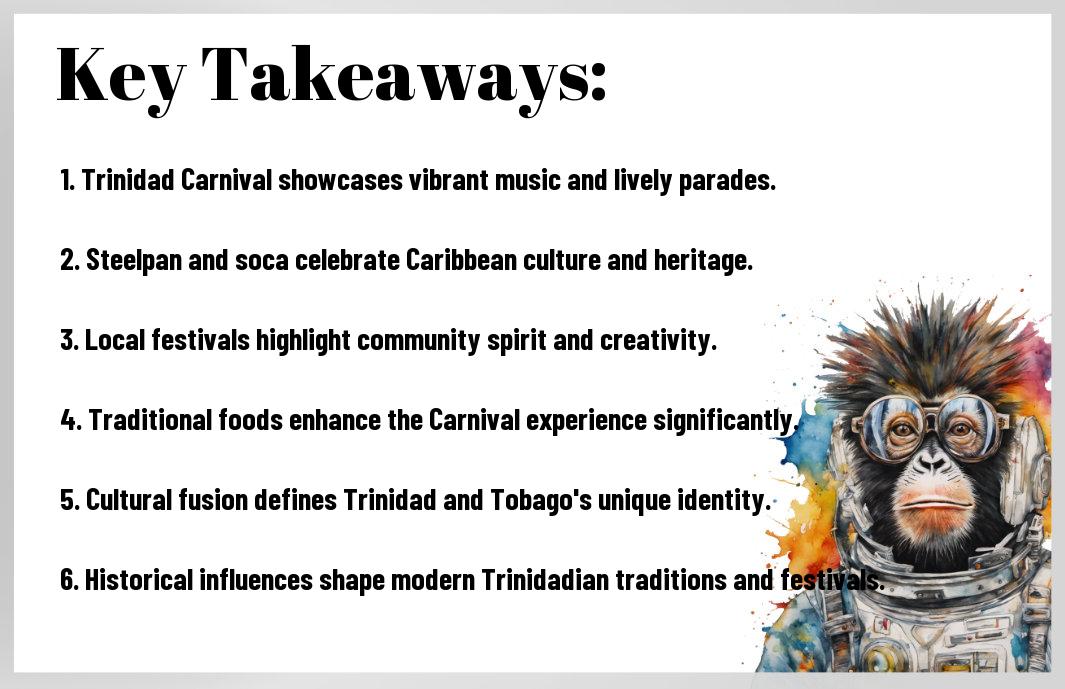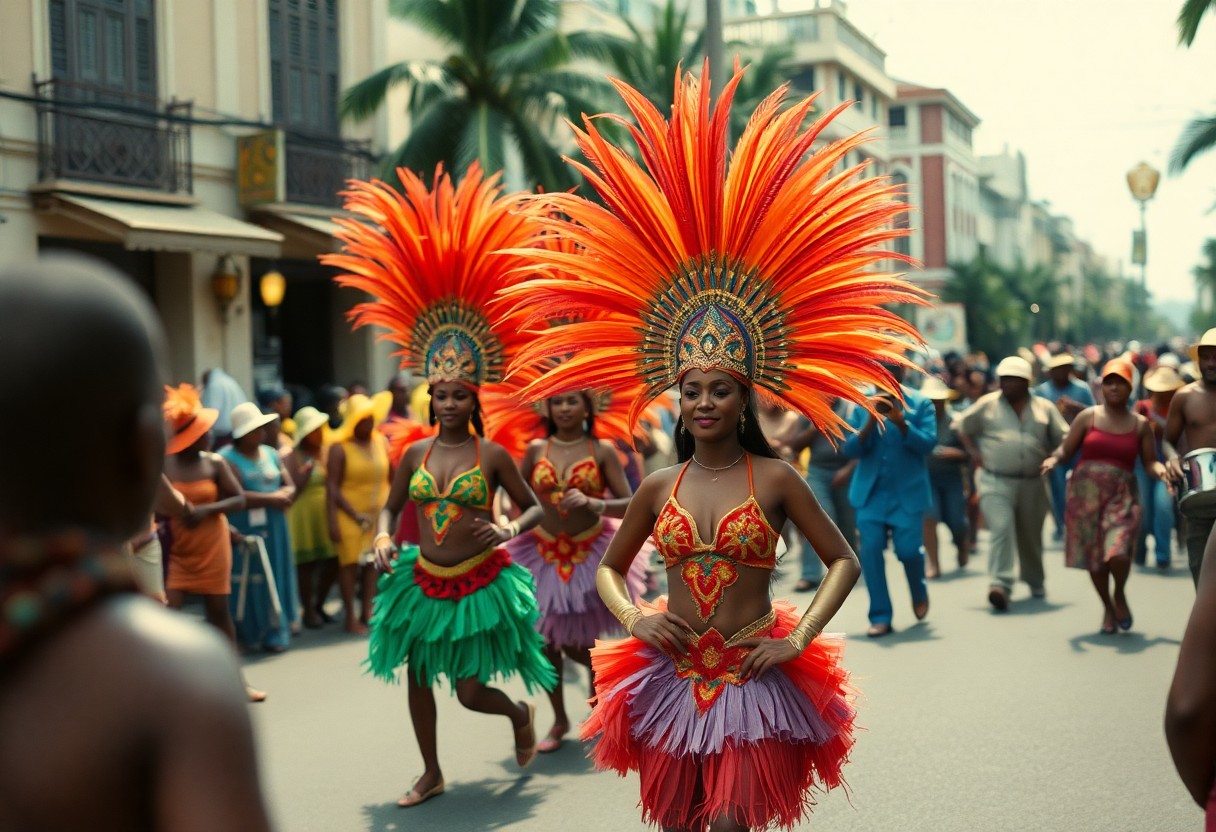Culture in Trinidad and Tobago is a vibrant tapestry woven from history, tradition, and celebration, with Carnival at its heart. You’ll discover how the lively festivities reflect the island’s rich heritage, showcasing music, dance, and artistic expression. Jesper Jacobi’s insightful tale provides you with a unique perspective on the experiences and stories that shape Trinidadian identity. Explore the various facets of this dynamic celebration and the cultural significance it holds for both locals and visitors alike, encouraging you to deepen your understanding of this enchanting Caribbean destination.

Historical Background
While Trinidad and Tobago boast a vibrant cultural tapestry, the historical backdrop that shaped Carnival is equally significant. It is rooted in the rich interplay of indigenous traditions, colonial influences, and African heritage, reflecting the islands’ complex past. Understanding this history allows you to appreciate the depth and diversity of Trinidadian Carnival, which transcends mere celebration to embody the struggles and triumphs of its people.
Colonial Origins of Trinidad Carnival
Behind the vibrancy of Trinidad Carnival lies a history steeped in colonialism. The festival’s origins trace back to the 18th century, during the period of French colonization. Europeans sought to replicate their own pre-Lenten festivities, leading to a fusion of cultural practices that laid the groundwork for modern Carnival traditions.
Evolution from French Masquerade to Local Celebration
Among the significant milestones in Carnival’s history is its transformation from a French masquerade into a uniquely Trinidadian celebration. This evolution symbolizes the merging of cultures and the adaptation of traditions by Afro-Trinidadians, who infused the festival with their own rhythms and narratives.
Even as Trinidad Carnival embraced elements of the French masquerade, it quickly evolved to reflect local identities and stories. You will notice how African rhythms, dance styles, and masquerade costumes became integral to the celebration, expressing both resistance and creativity. This fusion established a new cultural identity, where traditional performers, known as “mas’ bands,” developed unique interpretations that celebrate the island’s multicultural heritage. By participating in this rich tapestry, you become a part of a living history that honors the diverse influences that shaped modern Trinidadian Carnival.
Cultural Elements
The rich tapestry of Trinidadian culture is woven from its diverse influences, showcasing a vibrant blend of African, Indian, Spanish, and indigenous traditions. This melting pot manifests in every aspect of life, particularly during celebrations like Carnival, where cultural elements come alive through music, dance, and art. By immersing yourself in these experiences, you gain a deeper understanding of the island’s history and the enduring spirit of its people.
Calypso and Soca Music
An integral part of Trinidadian culture, Calypso and Soca music serves as a heartbeat for festivities and social commentary alike. You will find that Calypso has its roots in storytelling, often addressing social and political issues with wit and humor. Soca, a more contemporary evolution, energizes the Carnival vibe with infectious rhythms, inviting you to dance and revel in celebration.
Masquerade and Costume Traditions
Soca plays a key role in the masquerade and costume traditions of Trinidad and Tobago, enveloping you in a world of color and creativity during Carnival. The vibrant costumes, often made with intricate designs and materials, embody the spirit of revelry. Each masquerader takes on a character, showcasing unique and symbolic elements that reflect the nation’s rich heritage.
And as you immerse yourself in the spectacle, you’ll notice that each costume tells a story, from the traditional to the contemporary. Participants often spend countless hours crafting their attire, ensuring that every detail captures the essence of their character. The dynamic interplay of music, dance, and visual artistry creates an unforgettable experience, inviting you to celebrate not just the present but also the cultural roots of Trinidad and Tobago. You’ll leave with a lasting appreciation for the artistry and dedication behind the masquerade traditions.
Modern Carnival Structure
Keep in mind that the modern Carnival in Trinidad and Tobago is a meticulously organized event, consisting of various components that reflect the rich cultural heritage of the islands. The festivities span several weeks, culminating in vibrant celebrations that engage both locals and tourists alike. Understanding this structure will enhance your appreciation of the artistry and dedication that goes into each aspect of Carnival.
Pre-Carnival Events and Competitions
Along the lead-up to Carnival, you’ll discover a myriad of pre-Carnival events and competitions that set the stage for the main celebrations. These events, including calypso and soca competitions, steel pan contests, and various cultural showcases, build excitement while allowing you to immerse yourself in the local music and traditions, fostering a sense of community before the grand finale begins.
Main Carnival Days Organization
Modern Carnival days are meticulously organized, ensuring a seamless flow of activities that allow you to celebrate without missing a beat.
This well-structured organization includes a range of activities on both Carnival Monday and Tuesday, featuring vibrant parades, lively parties, and booming music that fill the streets. You can expect to see bands with beautiful masqueraders dressed in elaborate costumes, all making their way through designated routes. The experience is designed to be inclusive, welcoming everyone to partake in the revelry, while offering something for every taste—from traditional music to contemporary entertainment. This seamless organization allows you to fully engage in the spectacular and energetic atmosphere that defines Trinidad and Tobago’s Carnival.
Social Impact
Once again, the rich tapestry of Trinidad and Tobago’s culture comes alive during Carnival, weaving together a profound social impact that resonates with both locals and visitors. This annual celebration fosters unity among diverse communities, transforming the streets into vibrant showcases of creativity and camaraderie. You witness firsthand the way Carnival embodies the spirit of the nation, reinforcing cultural bonds and nurturing a sense of belonging, making it an necessary event that echoes the collective identity of Trinidadians.
Economic Significance
Before you investigate into the festivities, it’s important to consider the economic significance of Trinidad and Tobago’s Carnival. This grand event attracts thousands of tourists, generating substantial revenue for local businesses, accommodations, and the entertainment industry. The influx of visitors not only sustains jobs but also serves as a catalyst for economic growth, making Carnival a pivotal time for revitalizing the island’s economy.
Community Building and Identity
Among the most profound effects of Carnival is its power to foster community building and reinforce identity. The celebration transcends socioeconomic barriers, creating a space where everyone can express themselves through art, music, and dance.
At the heart of Carnival lies the deep-rooted sense of identity it cultivates within communities. Each neighborhood contributes unique traditions and performances, drawing you into a shared experience that strengthens social ties. As you engage in this vibrant atmosphere, you’ll notice how individuals from various backgrounds unite, celebrating their island’s heritage. This collective experience builds resilience within communities, allowing you to appreciate the rich cultural melange that defines Trinidad and Tobago while reinforcing the importance of belonging to something larger than yourself.
Religious Influences
After exploring the vibrant energy of Trinidad and Tobago’s Carnival, you may begin to uncover the deep religious influences that shape the culture. From the islands’ Catholic roots to the rich tapestry of African and Hindu practices, these elements intertwine, creating a unique cultural identity that resonates in every festival and celebration.
Catholic Traditions
Beside the joyful exuberance of Carnival, you’ll find that Catholic traditions play an integral role in Trinidadian culture. Festivals like Christmas and Easter are celebrated with great fervor, where you can immerse yourself in customs that reflect both spiritual significance and community bonding.
African and Hindu Elements
Hindu traditions also weave into the cultural fabric of Trinidad and Tobago, with influences stemming from the arrival of Indian indentured laborers. The vibrant celebration of Diwali, characterized by lights and sweets, combines beautifully with African customs, leading to a fascinating blend that enhances the islands’ religious landscape.
Another significant aspect is the way African and Hindu elements coexist and enrich Trinidadian spirituality. Rituals and practices from African religions, including vibrant festivals like Orisha celebrations, blend seamlessly with Hindu rites, creating a dynamic environment. This fusion not only reflects the diverse heritage of the islands but also fosters a sense of unity among various communities, allowing you to witness a unique coexistence that enhances the overall cultural experience.
International Recognition
For many, Trinidad and Tobago has become a recognized symbol of vibrant culture and celebration, especially through its Carnival. This world-renowned event raises questions about inclusivity, as explored in Who is Trinidad & Tobago’s Carnival For?. Aside from showcasing artistic talent, its global recognition fosters a connection between the islands and the world, promoting understanding and appreciation of Trinidadian culture.
Tourism and Global Appeal
After years of showcasing its colorful festivities, Trinidad and Tobago has developed a strong tourism sector fueled by the allure of Carnival. This annual event attracts millions from across the globe, eager to partake in the unparalleled experiences it offers. The festive atmosphere, combined with rich heritage, ensures that visitors return year after year, solidifying the islands’ reputation as a must-visit destination.
Cultural Exchange Programs
Appeal is another aspect of Trinidad and Tobago’s cultural landscape. Cultural exchange programs allow you to connect with diverse communities, enhancing your understanding of the rich tapestry of traditions. These initiatives not only foster appreciation for Trinidad’s heritage but also create avenues for collaboration among artists, musicians, and dancers worldwide.
In fact, many cultural exchange programs actively invite participants from different backgrounds to experience the magic of Trinidadian traditions firsthand. You can engage in workshops, learn instruments, or even join dance groups, enriching both your knowledge and appreciation of the vibrant culture. These interactions not only benefit you personally but also contribute to the global positioning of Trinidad and Tobago as a hub for cultural celebration and dialogue.
Summing up
To wrap up, as you immerse yourself in “Carnival and Culture – A Trinidadian Tale” by Jesper Jacobi, you gain a deeper appreciation for the vibrant traditions and rich cultural tapestry that define Trinidad and Tobago. The narrative not only highlights the exhilarating festivities of Carnival but also investigates into the historical and social contexts that shape this unique Caribbean nation. Engaging with this tale enables you to forge a stronger connection to the island’s spirit, enriching your understanding of its people and their profound love for celebration and community.




